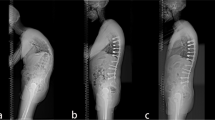Abstract
Objective
To report on the radiologic outcomes of different osteotomy position–selection strategies for a two-level osteotomy for correcting severe ankylosing spondylitis kyphosis.
Methods
From July 2009 to September 2016, a total of 46 patients in our department with severe ankylosing spondylitis kyphosis who underwent two-level pedicle subtraction osteotomy (PSO) were studied. Pre- and postoperative relevant parameters were recorded. The patients were divided into two types and further separated into four groups. The lumbar lordotic angle of Type I patients was larger than or equal to 0°. The lumbar lordotic angle of Type II patients was less than 0°. The patients of Group I belonging to Type I underwent superior spinal osteotomy at the L1 vertebra. The patients of Group II belonging to Type I underwent superior spinal osteotomy at the T12 vertebra. The patients of Group III belonging to Type II underwent superior spinal osteotomy at the L1 vertebra. The patients of Group IV belonging to Type II underwent superior spinal osteotomy at the T12 vertebra.
Results
Analysis of preoperative data showed that the lumbar lordosis (LL) of Group I and II patients was significantly larger than those of Group III and IV. Postoperative data analysis showed that there was significant difference among the four groups in the postoperative LL and TK. The LL of Group II and III patients was smaller than that of Group I patients, and was larger than that of Group IV patients. Group II and Group III patients had more moderate LL and better physiological curvature than those in Group I and Group IV. There were no significant differences between Group II and Group III patients in postoperative LL, thoracolumbar kyphosis, thoracic kyphosis, and global kyphosis. And, likewise, there were no significant differences among the four groups in cervical 7 sacrum angle (C7SA).
Conclusion
Two-level osteotomy was effective for correcting severe ankylosing spondylitis kyphosis. In patients with LL greater than or equal to 0°, it would be better if the second or superior spinal osteotomy was performed at T12 rather than at L1 for restoring the sagittal balance. In patients with LL smaller than 0°, it would be more satisfactory to perform two-level osteotomy at lumbar vertebras for correcting sagittal imbalance.
Level of Evidence
Level III.
Similar content being viewed by others
References
Chen IH, Chien JT, Yu TC. Transpedicular wedge osteotomy for correction of thoracolumbar kyphosis in ankylosing spondylitis: experience with 78 patients. Spine 2001;26:E354–60.
Kim KT, Suk KS, Cho YJ, et al. Clinical outcome results of pedicle subtraction osteotomy in ankylosing spondylitis with kyphotic deformity. Spine 2002;27:612–8.
Suk KS, Kim KT, Lee SH, et al. Significance of chin-brow vertical angle in correction of kyphotic deformity of ankylosing spondylitis patients. Spine 2003;28:2001–5.
Chang KW, Chen YY, Lin CC, et al. Closing wedge osteotomy versus opening wedge osteotomy in ankylosing spondylitis with thoracolumbar kyphotic deformity. Spine 2005;30:1584–93.
Bridwell KH. Decision making regarding Smith-Petersen vs. pedicle subtraction osteotomy vs. vertebral column resection for spinal deformity. Spine 2006;31:S171–8.
Kiaer T, Gehchen M. Transpedicular closed wedge osteotomy in ankylosing spondylitis: results of surgical treatment and prospective outcome analysis. Eur Spine J 2010;19:57–64.
Song RX, Zhang YG, Wang Y. Clinical efficacies of skipping two-level transpedicular wedge osteotomy for correction of severe kyphosis in ankylosing spondylitis. Zhonghua Yi Xue Za Zhi 2012;92:1476–80.
Zhang HQ, Huang J, Guo CF, et al. Two-level pedicle subtraction osteotomy for severe thoracolumbar kyphotic deformity in ankylosing spondylitis. J Eur Spine J 2014;23:234–41.
Zhao Y, Wang Y, Wang Z, et al. Effect and strategy of one-stage interrupted two-level transpedicular wedge osteotomy for correcting severe kyphotic deformities in ankylosing spondylitis. Clin Spine Surg 2017;30:454–9.
Ki-Tack, Kim, Lee SH, et al. Outcome of pedicle subtraction osteotomies for fixed sagittal imbalance of multiple etiologies: a retrospective review of 140 patients. Spine 2012;37:1667–75.
Bridwell KH, Lewis SJ, Lenke LG, et al. Pedicle subtraction osteotomy for the treatment of fixed sagittal imbalance. J Bone Joint Surg Am 2003;85:454–63.
Kawahara N, Tomita K, Baba H, et al. Closing-opening wedge osteotomy to correct angular kyphotic deformity by a single posterior approach. Spine 2001;26:391–402.
Chang KW, Cheng CW, Chen HC, et al. Closing-opening wedge osteotomy for the treatment of sagittal imbalance. Spine 2008;33: 1470–7.
Van Royen BJ, De Gast A. Lumbar osteotomy for correction of thoracolumbar kyphotic deformity in ankylosing spondylitis: a structured review of three methods of treatment. Ann Rheum Dis 1999;58: 399–406.
Xu H, Zhang Y, Zhao Y, et al. Radiologic and clinical outcomes comparison between single- and two-level pedicle subtraction osteotomies in correcting ankylosing spondylitis kyphosis. Spine J 2015;15:290–7.
Wang Y, Zhang Y, Mao K, et al. Transpedicular bivertebrae wedge osteotomy and discectomy in lumbar spine for severe ankylosing spondylitis. J Spinal Disord Tech 2010;23:186–91.
Schwab FJ, Blondel B, Bess S, et al. Radiographical spinopelvic parameters and disability in the setting of adult spinal deformity: a prospective multicenter analysis. Spine (Phila Pa 1976) 2013;38:E803–12.
Schwab F, Patel A, Ungar B, et al. Adult spinal deformity-postoperative standing 16 imbalance: how much can you tolerate? An overview of key parameters in 17 assessing alignment and planning corrective surgery. Spine (Phila Pa 1976) 2010;35:2224–31.
Been E, Kalichman L. Lumbar lordosis. Spine J 2014;14:87–97.
Author information
Authors and Affiliations
Corresponding authors
Additional information
IRB Approval: This study was reviewed and approved by the hospital research Ethics Committee.
Author disclosures: CL (none); GZ (none); YG (none); KS (none); XT (none); XZ (none); ZW (none); YW (none).
Rights and permissions
About this article
Cite this article
Liu, C., Zheng, G., Guo, Y. et al. Two-Level Osteotomy for Correcting Severe Ankylosing Spondylitis Kyphosis: Radiologic Outcomes of Different Osteotomy Position-Selection Strategy for Different Type of Patients. Spine Deform 6, 273–281 (2018). https://doi.org/10.1016/j.jspd.2017.10.011
Received:
Revised:
Accepted:
Published:
Issue Date:
DOI: https://doi.org/10.1016/j.jspd.2017.10.011




